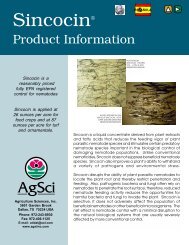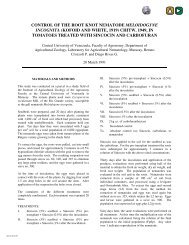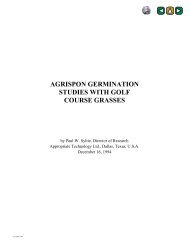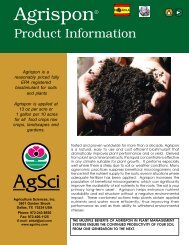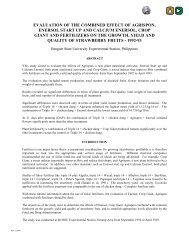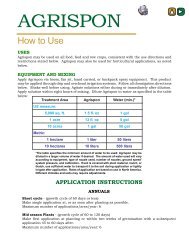R325 - Effect of Different Rate of Azotobacter ... - Agrisciences.com
R325 - Effect of Different Rate of Azotobacter ... - Agrisciences.com
R325 - Effect of Different Rate of Azotobacter ... - Agrisciences.com
You also want an ePaper? Increase the reach of your titles
YUMPU automatically turns print PDFs into web optimized ePapers that Google loves.
Table 1. Chemical Composition <strong>of</strong> Onion (100g fresh product)<br />
Determination<br />
Unit<br />
Water and cellulose 86.10%<br />
Calcium<br />
0.34 mg<br />
Potassium<br />
0.17 mg<br />
Sodium<br />
0.016 mg<br />
Phosphorus<br />
0.045 mg<br />
Chlorine<br />
0.021 mg<br />
Sulfate<br />
0.07 mg<br />
Proteins 1.60%<br />
Fat 0.50%<br />
Hydrates <strong>of</strong> Carbon 11.60%<br />
It also contains a large amount <strong>of</strong> vitamin A, and a satisfactory quantity <strong>of</strong> both vitamin B and C. Their energy<br />
value is 0.45 calories per gram (TISCORNIA, R. 1974).<br />
The onion requires a temperate warm climate for its development, but the ideal condition is cool temperatures in the<br />
initial phase <strong>of</strong> development and warm toward maturity. Good temperatures are considered to be from 12° to 24°C<br />
(CÁCERES E. 1982). Thusly it is considered that the best growth <strong>of</strong> the cultivation is obtained with temperatures<br />
around 16° to 18°C, also, in temperate climates they need temperatures above 20°C to form bulbs (MESSIAEN, C.<br />
1979).<br />
The cultivation is affected strongly by day length and length <strong>of</strong> photo-period. Some varieties grown in temperate<br />
areas don't develop bulbs <strong>com</strong>pletely in tropical areas, or even in subtropical areas; they are very developed<br />
vegetatively but need days with 15 hours <strong>of</strong> sun light for bulb development (MORTENSEN, E. 1967).<br />
The most desirable soils are calcareous, sandy, loose and aerated; in tight soils small, non-<strong>com</strong>mercial bulbs are<br />
developed; onions don't tolerate soil already low in organic matter or purin (TAMARO, D. 1977).<br />
Checking results <strong>of</strong> the application <strong>of</strong> fertilizer nitrogen (75 kg/ha) shows a statistically superiority to control<br />
treatment (00 kg/ha), in that yields <strong>of</strong> 45,708 kg/ha and 30,312 kg/ha <strong>of</strong> onions were achieved in Red Arequipeña<br />
onions (SILVA, A. 1982).<br />
Likewise, using the same variety as control, a yield <strong>of</strong> 7,271 kg/ha was obtained, bulb diameter averaged 6.66 cm,<br />
and a high statistical significance (95 and 99%) existed among characteristic <strong>of</strong> diameter <strong>of</strong> bulb vs. yield (RED, C.<br />
1977).<br />
For nitrogen incorporation into the soil, one <strong>of</strong> the most important microorganisms is the aerobic bacteria<br />
<strong>Azotobacter</strong>, discovered by the Dutch microbiologist Beijerinck, which are characterized as heterotrophic.<br />
(BONNER, J, 1973), (BURGES, J.)<br />
In the mature state, the bacteria are an oval shape, which may be for accumulation <strong>of</strong> big globules <strong>of</strong> fat. Most have<br />
a more or less rigid membrane that represents 20-25% <strong>of</strong> the dry matter <strong>of</strong> the microorganism; some <strong>of</strong> the<br />
membranes seem to be formed mainly by lipoproteins, in others by mucoproteins. Free living organisms prefer<br />
rizospheres <strong>of</strong> well-aerated soils; they feed on organic <strong>com</strong>pounds synthesized by autotrophic organisms and<br />
healthy plants (BURGES, A. 1971), (BURDON, K. 1971).<br />
These bacteria use and oxidize organic matter: they spend energy in part liberated in the process <strong>of</strong> substratum<br />
oxidation in the processes <strong>of</strong> nitrogen reduction (BONNER, J. 1973); they take nitrogen directly from the air which<br />
<strong>com</strong>bines inside the cellular plasma which is liberated in the form <strong>of</strong> nitrates (BURDON K. 1971). Neither starch<br />
nor the other polysaccharides are used. It grows well in the presence <strong>of</strong> nitrogen generating substances like nitrates,<br />
ammonium salts or urea, but if these substances are abundant, they don't fix atmospheric nitrogen (JAMES. W.<br />
1967).<br />
2




